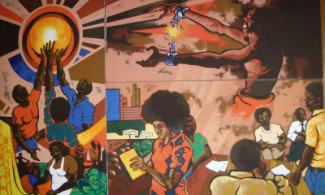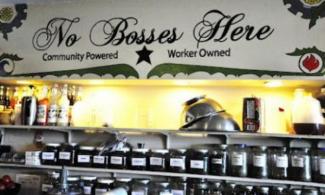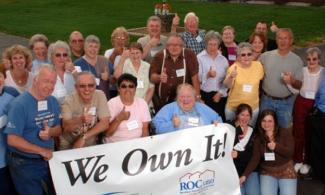Lessons Learned from the 1980s

This brief review examines three articles from Changing Work characteristic of the issues and movements covered during the mid-1980s by what is now Grassroots Economic Organizing. My purpose is to briefly assess some of the successes, challenges, and lessons afforded to us through hindsight as we continue to report on and help build a more fully democratic economy.
First, a look at Ana Gutierrez-Johnson's 1984 piece on Mondragon, the Spanish Basque network of worker owned and managed cooperatives, and the institutional innovations underlying its sustained success. Second, an overview, in 1985, by Suzanne Gordon and Frank Clemente of the economic conversion movement, and some thoughts on its disappearance from the public agenda. Third, Severyn Bruyn's 1986 proposal for so-called "Home Grown" or self-reliant communities, along with both David Morris' account of how this process fared in St. Paul, MN and my own thoughts on similar initiatives today. Finally, I'll trace some common features of these three examples and their future implications for GEO and its readership.
Mondragon's Institutional Success
Mondragon has been seen, world-wide, as a model of cooperative enterprise and workplace democracy. Thirty years ago, Ana Gutierrez-Johnson examined the success and transferability of practices from and within this network of cooperative production enterprises. She writes that the following processes modified traditional cooperative principles and laid the groundwork of Mondragon's success through today:
1. For the acquisition of capital, a cooperative bank, Caja Laboral, was established which offered comparatively high rates of return on savings deposits.
2. Members' shares of the annual profits were reinvested in their co-ops at an attractive interest rate so that the organization could capitalize on 100 percent of its profits. Members receive their share plus the interest accrued upon retirement or leaving the firm.
3. Members' annual incomes were fixed at a very low ratio between the highest and lowest paid jobs. This further maximized the trust and equity between various members.
4. New members were required to pay a low-level entrance fee, which could be paid through salary deductions over time.
This framework forms the institutional foundation for what Gutierrez-Johnson calls "labor-entrepreneurship" within the Mondragon cooperative network. For her, labor-entrepreneurship is characterized by "the active role assumed by the associated workers, the collective decision-making process and the labor based vision of development". This model of internal innovation proves successful due to the primacy of labor in the productive process. Organizationally, worker-owners are invested at several points and levels so that their personal success is reliant on the success of their enterprise, and vice-versa. The worker-owners are thus committed to cooperate and innovate in the face of any and all challenges.
These features continue to inform Mondragon's business model. They have allowed the organization to succeed since the 2008 financial crisis despite the significant impact of this crisis throughout much of the rest of Spain. In the USA, new social enterprises have adopted many features of this model, e.g., the United Steel Workers plan to partner with Mondragon in developing union-based worker cooperatives, and the Evergreen Cooperative network in Cleveland, but these initiatives will need lots more time before their long term success can be assessed.
While it is arguably the most widely recognized, Mondragon is but one example of what cooperative structures can look like. Today, the cooperative economy continues to build as more people recognize the benefits of membership in the businesses they use: from cooperative grocery stores, to credit unions, to cooperative health insurance, cooperatively owned and operated workplaces, and more. The models and forms of these collective businesses is as diverse as the communities they serve.
Two significant differences between Mondragon and these new models are scale and inter-cooperative coordination. As an international cooperative managing over 33 billion Euros of assets, Mondragon has the capacity to shift significant resources towards new developments and labor-initiated innovations. This growth can be attributed, in part, to the institutional innovations listed above; but, also to its creation of an interconnected network of finance, manufacturing, education, and research cooperatives coordinating within a single organization. At this point, many of the cooperatives in America's emerging "new economy" work independently and lack the resources to commit to capacity-building, and network development.
Three trends in the contemporary cooperative movement provide possible avenues for enabling innovation and inter-cooperative coordination. Cooperative academies, like the one offered by Green Worker Cooperatives in the Bronx (www.greenworker.coop) aim to empower startups through business training as well as to become hubs for building local cooperative networks. Cooperative financials institutions like the Cooperative Fund of New England (www.cfne.coop) provide cooperatives with the resources necessary to take on large-scale projects. Financial advisors at cooperative funds can better work with cooperatives than corporate banks. Finally, there is the recent emergence of regional networks of cooperatives, many based on the 6th cooperative principle that cooperatives support other cooperatives (see here PACA, the Philadelphia Area Cooperative Alliance: www.philadelphia.coop). Moving forward, GEO will continue to highlight new models such as these three, to encourage the type of organizational and labor-based innovation which drives Mondragon's sustained success.
Economic Conversion
The economic conversion movement arose in reaction to the military-industrial complex developed during the Cold War and carried on during the Vietnam conflict. Its goal was to shift from a war economy to a peace economy; it aimed at both impacting public policy and shifting single factories away from producing the machinery of war. The language of conversion has largely faded from public discourse, but the movement offers many lessons applicable to contemporary issues and activism around weapons production and curbing the proliferation of military armaments.
In their 1985 article, Gordon and Clemente describe economic conversion as "the process through which workers, communities and businesses transform industries to produce socially useful goods". For them this process requires the coordination of industry policy leaders, workers, and local communities. Rather than simply an ideal, conversion demands concrete plans for each industry and each plant embedded within the industrial-military complex to ensure the large-scale transfer of resources from the military to the civilian population.
The Lucas Plan, which originated in the UK, provides an iconographic example of economic conversion. Facing widespread layoffs in 1976, the workforce of one of the many factories of Lucas Aerospace developed a plan for converting the plant from the production of military weaponry to socially useful products, such as medical equipment, light rail, and on-and-off road vehicles. Ultimately, the plan was not successfully implemented; but it continues to provide a model for what this process could look like.
While the proliferation of nuclear military capabilities characteristic of the 1980s has subsided, the magnitude of the industry has not. In the current context where the United States spends more on its military than the next ten nations, it may be time to revisit the aspirations of the conversion movement.
We might look to gun control and anti-war advocates as contemporaries of the economic conversion movement. They face powerful military and industry lobbyists who argue American jobs depend on the current rate of expenditure supporting our "garrison society". Peace activists suggest that the money can be funneled from the weapons industries into other sectors, such as education, health, social services, or green technology. Whether this is the case, or would even be palatable to most workers in those industries, are questions that those supporting these forms of conversion must wrestle with.
Self-Reliant Communities
The spring 1986 issue of Changing Work focused on "The Home Grown Economy" and presented a range of strategies and models for local economic growth and control. The problem, according to issue editor Severyn Bruyn, is that modern businesses are beholden to capital investors rather than the communities they are embedded within. The pursuit of ever-increasing returns leads corporations to pursue ever-cheaper labor sources and production locations. The economic benefits industries bring to communities are fleeting, but the social and environmental costs have enduring legacies.
Bruyn argues that reversing this economic trend requires local control and democratic management over the means of production: land, labor, and capital. He emphasizes the importance of community land trusts over traditional real estate, worker control over big corporate management, and community development credit unions over banks as the ways to regain local control over land, labor, and capital. Beyond these basic means of production, Bruyn suggests communities embrace economic diversity, closing ecological loops, and maximizing local social and technological inventions.
Given the complexity of the task, Bruyn and most of the contributors in this issue emphasize the primary role city planning and local governance play in the coordinating these disparate efforts. They claim that through community development corporations (CDCs) and city government outreach, local citizens would have more control over the direction of development. They saw city planners as enabling these local efforts through financial and technical assistance, while maintaining a city-wide vision of moving towards self reliance.
David Morris discussed the ways in which this model of self-reliance played out in the city of St. Paul, MN. Mayor George Latimer's 1983 vision to create stable jobs and a strong local economy led to strategies for conserving local energy, converting corporations to employee ownership, and developing neighborhoods through participatory methods of citizen engagement. In a letter to city employees, Latimer wrote, "The Homegrown Economy presents a new orientation for the city and a new approach to using our community's resources. It seeks to make the city more economically self-reliant, producing and nurturing economic growth from within, instead of waiting on outside forces". This approach requires top-down leadership and coordination with a city government working to bring together various initiatives. The project foundered within a few years, in part because Mayor Latimer stepped down and state funds from Minnesota to the city were cut.
Morris contends that the challenge of this home grown approach is that "[t]here is no natural constituency supporting local self-reliance as there is, say, in support of construction". Absent the top-down vision for self-reliance, Morris sees a limited possibility for this to develop. As political fads fade, and elected officials come and go, so too will the support for these types of initiatives.
City planning at the local level has not proven to be a panacea, partly for the reasons Morris gives, but the concept of self-reliant communities has not disappeared. Over the past thirty years new models and movements have arisen in an effort to empower local communities using diverse networks of organizations working with or parallel to local government. Local currencies, social entrepreneurship, transition towns, solidarity economies, community planning and visioning, and more are examples of contemporary movements focusing on much more bottom-up strategies to achieve local economic control and resilience. "Home Grown" may well have been revived, in a more effective and sustainable form.
Looking Ahead
One challenge faced by all three of these movements from decades ago was what Morris referred to as a lack of a "natural constituency", one that could unite worker and citizens. In our current context, this is no longer true. The issue of local economic control continues to plague communities in the aftermath of the 2008 financial crisis that disproportionately impacts low-income communities and urban centers. It also created a new class of newly poor middle-class laborers as families watched their retirement plans and investments disappear and home owners lost their homes to foreclosure. This presents a new set of challenges to address within a political era of austerity and decreasing social spending, but it also creates a common set of needs across a broad base.
Also, these movements drew inspiration from international models, particularly in the cases of the Mondragon cooperative phenomenon and the UK's Lucas Plan for economic conversion. Today, there are many successful examples within the American context that we can look to. The Transition Town movement (www.transitionnetwork.org) and organizations like Everyday Democracy (www.everyday-democracy) provide new models of how communities can address issues through locally-grounded initiatives.
Examples of this sort may well have a substantial and growing constituency, as well as showing how lessons and solutions can 'trickle-up' through networks of autonomous groups to central informational hubs rather than 'trickle-down' from remote centralized planning and resource distribution. As we move forward, we must find solidarity with new allies in that expanding constituency to address the issues of government austerity, corporate bloat, financial fragility, racial oppression, military expansion, and all the other forms of domination embedded within our society. Rather than providing simplistic blueprints or duplicating what has worked elsewhere, we can offer witness and compassion for all those who strive to change work and life for the better.
This survey is not meant to be comprehensive. Glaring in their absence is GEO's coverage of initiatives addressing issues of environment, gender, health, education, and race. We encourage readers to go back into the archives and send us summary reports on their favorite articles and issues; these can guide – or become articles in – GEO as we continue to be a source of research and encouragement for those committed to changing work.
Works Cited or Drawn Upon
- Bruyn, Severyn.
- "Working in Self-Reliant Communities". Changing Work, Spring, 1986.
- Gordon, Suzanna and Frank Clemente.
- "Basics of Conversion". Changing Work, Winter, 1985.
- Gutierrez-Johnson, Ana.
- "The Mondragon Cooperative Model". Changing Work, Fall, 1984.
- Morris, David.
- "The Self-Reliant City: St. Paul, MN". Changing Work. Spring, 1986.
- Wainwright, Hilary and Dave Elliot.
- The Lucas Plan, A New Trade Unionism in the Making? London, Allison & Busby. 1982.
Citations
Lazri DiSalvo (2013). Looking Back: Lessons Learned from the 1980s. Grassroots Economic Organizing (GEO). https://geo.coop/story/looking-back




Add new comment